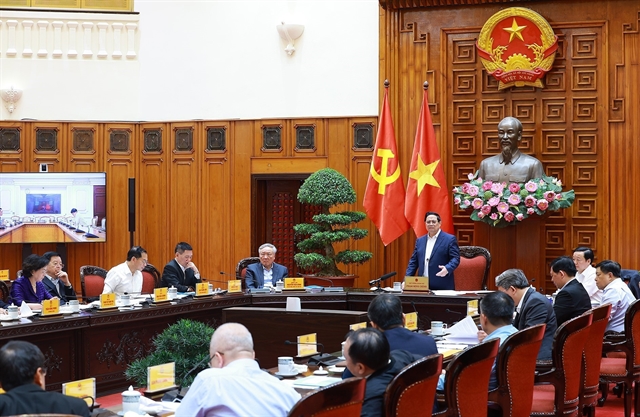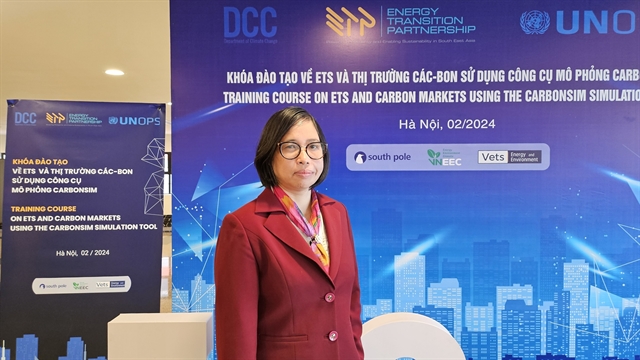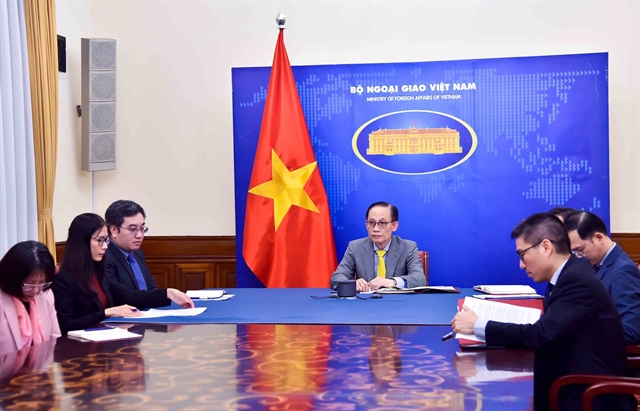 Economy
Economy


|
| Đặng Hồng Hạnh is a climate change policy expert from Energy and Environment Consultancy (VNEEC). — VNS Photo Ly Ly Cao |
HÀ NỘI — Việt Nam is poised to take a significant step towards its involvement in the global carbon market by launching a pilot emission trading system (ETS) in 2025. However, a recent survey reveals that with only one year remaining until its implementation, companies participating in the pilot still have limited understanding and awareness of the ETS and the carbon market. In order to shed light on this issue, Việt Nam News’ reporter Ly Ly Cao talked to Đặng Hồng Hạnh, a climate change policy expert from Energy and Environment Consultancy (VNEEC), to explore the opportunities and challenges domestic enterprises face when joining the ETS.
What is the ETS?
It is just a trading floor where sellers and buyers meet and perform transactions, boosting trades. However, unlike normal commodities or stock exchanges, the goods traded on the ETS are carbon allowances, which are issued by the Government to allow a company or entity to emit a specific quantity of carbon dioxide (CO2) equivalent into the atmosphere.
How important is this system?
The system is helping us move closer to achieving the commitment to reduce greenhouse gas emissions (GGE).
The country has set a national emissions reduction objective. Subsequently, it will be allocated to companies or entities in the economy, where the emissions occur. These units will be responsible for implementing the emission reduction measures in their respective locations. Alternatively, units that have the potential to increase sources, such as absorption or generate other emission reductions, such as from renewable energy sources, can also contribute to the overall goal.
The basic principle of economics is that the cost of implementing emission reductions will vary greatly across different industries, technologies and businesses. It depends on the capabilities, technologies and ambitions of each entity.
As a result, if we impose the same emission reduction targets without allowing these units to engage in trading, it would result in a higher overall cost for society to achieve the desired emission reductions.
However, by permitting trading, we can more efficiently achieve the reductions. Entities can sell their emission reductions at a lower price, surpassing the government's requirements. They can then purchase these reductions at a lower cost than if they were to implement the reduction measures within their own business. This creates an economic incentive for investments, such as in technology, education or training.
What are the obstacles to running the system?
The primary long-term challenge, particularly in achieving a shared commitment to the national goal, lies in obtaining consensus among the parties involved.
Meanwhile, one of the initial legal challenges is to establish a legal framework that defines the nature of this commodity, its legal basis, and the extent of its governance.
How does this pilot affect enterprises in the economy?
The impact differs among businesses, with some experiencing a lesser degree of impact. This is because they have already made preparations in terms of infrastructure and personnel to align with the policy.
However, there are other businesses that are relatively new to the policy, and when it is implemented, there will be a specific and defined deadline. If they fail to meet the imposed requirements within that timeframe, they may be subject to government penalties.
Based on Decision 01/2022 issued by the Prime Minister, there are 1,912 identified large waste-generating enterprises, which are closely related to the list of energy-intensive enterprises.
However, not all of these enterprises will be obligated to participate in the pilot. Instead, a selected number of large enterprises, particularly the largest ones, will be required to join the initiative.
These companies also have concerns about the additional costs associated with conducting greenhouse gas inventories and implementing waste reduction measures.
For small and medium-sized enterprises (SMEs), the impact of this policy can be indirect, as they are part of supply chains. If there are additional costs associated with meeting the emission reduction obligations, it will likely result in higher product prices. Consequently, these costs will be passed on to consumers by SMEs, thereby affecting the overall pricing of their products.
Do you have any advice for companies?
I only have one suggestion: make preparations.
Businesses should be proactive and have a strategic approach in adapting to the impacts of such policies. This means that even if a business is not currently included in the list, they should still make preparations for it within the upcoming year.
It's important to understand that the list of businesses is not limited to the initial 1,912 enterprises. The publicly disclosed draft version indicates that the list has expanded to nearly 3,000 businesses. This list will be regularly adjusted and updated. Therefore, businesses with similar emissions levels or operating in related industries should also take note and make advance preparations.
Businesses taking a proactive and prepared approach are more likely to succeed. And in the long term, this policy can also be extended to encompass SMEs. — VNS




